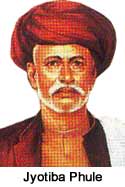

 |  |
 In Maharashtra and Madras, clear cut Brahman domination over the services and general cultural life was already leading to anti-Brahmanical movement by the end of the century. The anti-Brahman tocsin was first sounded in Maharashtra in the 1870s by Jyotiba Phule with his book. Ghulam-giri (1872) and his organization, the Satyashodhak Samaj (1873), which proclaimed the need to save the 'lower castes from the hypocritical Brahmans and their opportunistic scriptures'. In Maharashtra and Madras, clear cut Brahman domination over the services and general cultural life was already leading to anti-Brahmanical movement by the end of the century. The anti-Brahman tocsin was first sounded in Maharashtra in the 1870s by Jyotiba Phule with his book. Ghulam-giri (1872) and his organization, the Satyashodhak Samaj (1873), which proclaimed the need to save the 'lower castes from the hypocritical Brahmans and their opportunistic scriptures'. Started by an urban-educated member of the lowly mali (gardening) caste, this movement later struck some roots among the predominantly peasant Maratha caste-cluster. There was also a second trend, working in villages rather than towns (unlike most other l9th century social reform movements) and using the Marathi vernacular rather than English; which attacked the caste system rather than merely claiming a higher status within it, and claimed to speak for the bahujan samaj against the shetji-bhatji (moneylenders and Brahmans). It inspired peasant risings in Satara in 1919-21, and later helped to revitalize the Gandhian Congress in rural Maharashtra. A somewhat similar pattern can be seen a little later in Madras, as the undoubted Brahman predominance in education and services (Brahmans accounted for 3.2% of the Presidency population, but about 70% of Madras University graduates between 1870 and 1918) came to be challenged by educated Tamil Vellalas; Telegu Reddis and Kammas, and Malayali Nairs. Also there are evidences of British encouragement of what eventually became a kind of 'Dravidian' or Tamil separatism. This was to be quite obvious with the Justice Party of the 1920s and '30s, but as early as 1886, a convocation address by the Governor of Madras makes an interesting reading: 'You are a pure Dravidian race. I should like to see the pre-Sanskrit element amongst you asserting itself rather more. You have less to do with Sanskrit than we English have. Ruffianly Europeans have sometimes been known to speak of natives of India as "Niggers", but they did not, like the proud speakers or writers of Sanskrit, speak of the south as the legions of Monkey'. As with many other types of internal tensions, imperialists here made a skilful use of real grievances to foster sectional tension. next page >> |
Copyright ©2000 indiansaga.info. All rights reserved.
By using this service, you accept that you won't copy or use the data given in this website for any commercial purpose.
The material on indiansaga.info is for informational & educational purpose only.
This site is best viewed at 800 X 600 picture resolution.